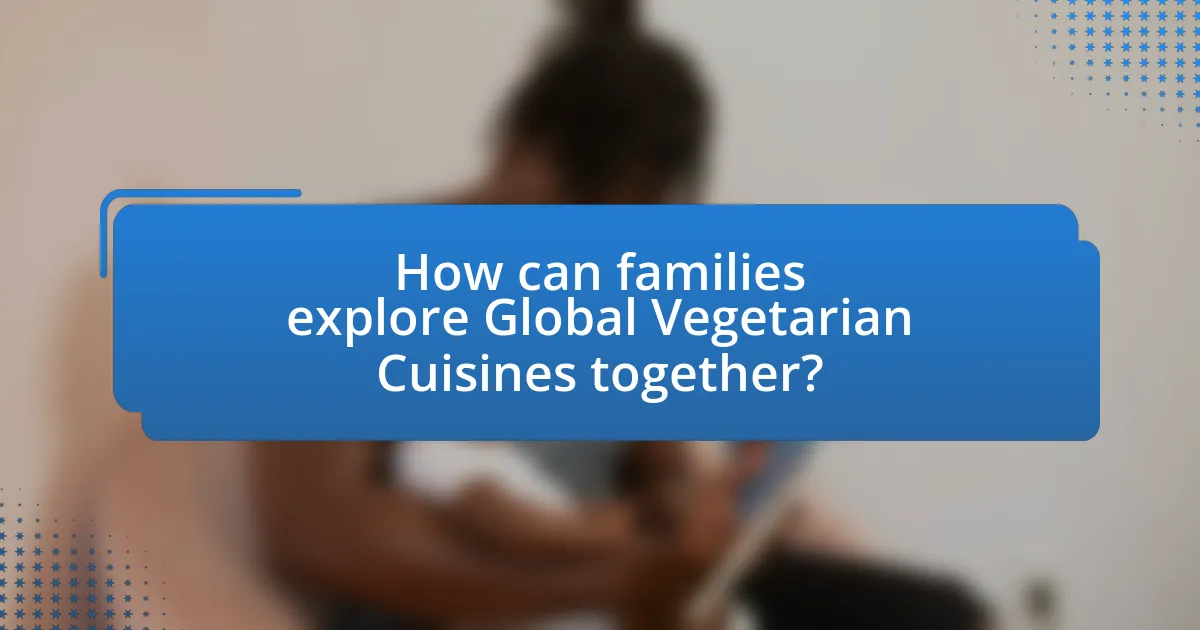Global Vegetarian Cuisine encompasses a wide variety of plant-based dishes and culinary traditions from around the world, highlighting regional flavors and cooking techniques. This article explores the differences between Global Vegetarian Cuisine and traditional vegetarian diets, emphasizing the importance of cultural influences, local ingredients, and historical contexts in shaping these cuisines. It also discusses the health benefits of vegetarian diets, the significance of exploring diverse culinary options as a family, and practical tips for incorporating global vegetarian dishes into daily meals. Families are encouraged to engage in cooking activities, explore local vegetarian restaurants, and utilize various resources to enhance their culinary experiences and cultural awareness.

What is Global Vegetarian Cuisine?
Global Vegetarian Cuisine refers to a diverse array of plant-based dishes and culinary traditions from around the world. This cuisine encompasses various regional flavors, ingredients, and cooking techniques, reflecting the cultural heritage and dietary practices of different societies. For instance, Indian cuisine features dishes like dal and paneer, while Mediterranean cuisine includes falafel and hummus. The global shift towards vegetarianism is supported by studies indicating health benefits and environmental sustainability, making Global Vegetarian Cuisine increasingly popular.
How does Global Vegetarian Cuisine differ from traditional vegetarian diets?
Global Vegetarian Cuisine differs from traditional vegetarian diets primarily in its incorporation of diverse cultural flavors and cooking techniques from around the world. While traditional vegetarian diets often focus on local ingredients and familiar dishes, Global Vegetarian Cuisine embraces a wide array of spices, ingredients, and culinary practices from various cultures, such as Indian, Mediterranean, and Asian cuisines. This results in a broader spectrum of flavors and textures, enhancing the overall dining experience. For instance, dishes like Indian chana masala or Thai green curry showcase unique flavor profiles that are not typically found in traditional vegetarian meals, which may rely more on basic preparations like salads or vegetable stir-fries.
What are the key characteristics of vegetarian cuisines around the world?
Vegetarian cuisines around the world are characterized by their diverse use of plant-based ingredients, regional spices, and cooking techniques. These cuisines often emphasize fresh vegetables, legumes, grains, nuts, and fruits, reflecting local agricultural practices and cultural traditions. For example, Indian vegetarian cuisine incorporates a wide variety of spices and lentils, while Mediterranean vegetarian dishes often feature olive oil, herbs, and fresh vegetables. Additionally, many vegetarian cuisines are influenced by religious practices, such as Hinduism and Buddhism, which promote vegetarianism, leading to unique culinary practices and recipes specific to those cultures.
Why is it important to explore vegetarian options globally?
Exploring vegetarian options globally is important because it promotes dietary diversity and sustainability. A diverse vegetarian diet can enhance nutritional intake by incorporating a wide range of fruits, vegetables, grains, and legumes, which are essential for health. Additionally, adopting vegetarian diets can significantly reduce environmental impacts; for instance, a study published in the journal “Nature” found that shifting towards plant-based diets could reduce greenhouse gas emissions by up to 70% by 2050. This highlights the critical role of vegetarian options in addressing climate change and promoting global food security.
What are the cultural influences on Global Vegetarian Cuisine?
Cultural influences on Global Vegetarian Cuisine stem from diverse traditions, religious practices, and regional ingredients. For instance, Indian cuisine heavily incorporates vegetarianism due to Hindu beliefs that promote ahimsa, or non-violence, leading to a rich variety of plant-based dishes like dal and sabzi. Similarly, Mediterranean diets emphasize vegetables, legumes, and grains, influenced by the agricultural practices of countries like Greece and Italy, where the climate supports a wide range of produce. Additionally, Buddhist teachings in countries such as Thailand and Japan advocate for vegetarianism, resulting in dishes like Thai green curry and Japanese vegetable tempura. These cultural factors shape the global vegetarian landscape, showcasing a blend of flavors and cooking techniques that reflect local customs and beliefs.
How do local ingredients shape vegetarian dishes in different regions?
Local ingredients significantly shape vegetarian dishes in different regions by influencing flavor profiles, nutritional content, and culinary traditions. For instance, in Mediterranean regions, the abundance of olives, tomatoes, and fresh herbs leads to vibrant dishes like ratatouille and tabbouleh, which highlight these local produce. In contrast, Indian vegetarian cuisine utilizes spices such as turmeric and cumin, along with locally grown lentils and vegetables, resulting in dishes like dal and aloo gobi that are rich in flavor and nutrition. This regional specificity not only enhances the taste but also reflects the agricultural practices and cultural heritage of the area, making local ingredients essential to the identity of vegetarian dishes worldwide.
What role does history play in the development of vegetarian cuisines?
History plays a crucial role in the development of vegetarian cuisines by shaping dietary practices based on cultural, religious, and environmental factors. For instance, ancient civilizations such as India and Greece incorporated vegetarianism due to spiritual beliefs and philosophical teachings, with texts like the Bhagavad Gita promoting non-violence towards animals. Additionally, the rise of vegetarianism during the 19th century in Europe was influenced by the health movement and the establishment of vegetarian societies, which advocated for plant-based diets. These historical contexts illustrate how vegetarian cuisines evolved in response to societal values and ecological considerations, leading to diverse culinary traditions worldwide.

How can families explore Global Vegetarian Cuisines together?
Families can explore global vegetarian cuisines together by engaging in cooking sessions that focus on recipes from various cultures. This hands-on approach allows family members to learn about different ingredients, cooking techniques, and cultural significance behind each dish. For example, preparing Indian dal, Italian risotto, or Mexican enchiladas can introduce families to diverse flavors and culinary traditions. Additionally, families can visit international markets to discover unique spices and vegetables, enhancing their understanding of global cuisines. Cooking classes or online tutorials can further facilitate this exploration, providing structured guidance and inspiration.
What activities can families engage in to learn about vegetarian cuisines?
Families can engage in cooking classes focused on vegetarian cuisines to learn about various dishes and ingredients. These classes often provide hands-on experience, allowing families to prepare meals from different cultures, such as Indian, Mediterranean, or Asian vegetarian dishes. Participating in local food festivals that celebrate vegetarianism can also enhance understanding, as these events showcase diverse vegetarian options and cooking techniques. Additionally, families can explore vegetarian cookbooks or online resources together, which often include recipes and cultural context, fostering a deeper appreciation for vegetarian cuisines.
How can cooking classes enhance family bonding while exploring cuisines?
Cooking classes can enhance family bonding while exploring cuisines by providing a collaborative environment where family members work together to create meals. This shared experience fosters communication and teamwork, allowing families to connect over the preparation and enjoyment of diverse dishes. Research indicates that cooking together can improve relationships, as it encourages interaction and the sharing of cultural traditions, which is particularly relevant when exploring global vegetarian cuisines. Engaging in this culinary journey not only teaches valuable cooking skills but also promotes understanding and appreciation of different cultures, further strengthening family ties.
What are some fun family-friendly recipes from various cultures?
Some fun family-friendly recipes from various cultures include Mexican quesadillas, Italian pasta primavera, Indian vegetable samosas, and Japanese sushi rolls. Quesadillas are easy to make by filling tortillas with cheese and vegetables, then grilling them until crispy. Pasta primavera features seasonal vegetables tossed with pasta and a light sauce, making it colorful and nutritious. Vegetable samosas are savory pastries filled with spiced potatoes and peas, perfect for baking or frying. Sushi rolls can be made with rice, vegetables, and avocado, allowing families to customize their ingredients. These recipes not only introduce children to diverse flavors but also encourage family bonding through cooking.
Why is it beneficial for families to explore vegetarian cuisines?
Exploring vegetarian cuisines is beneficial for families because it promotes healthier eating habits and encourages diverse culinary experiences. Research indicates that vegetarian diets can lower the risk of chronic diseases such as heart disease, diabetes, and certain cancers due to their high content of fruits, vegetables, and whole grains. Additionally, engaging in vegetarian cooking together fosters family bonding and cultural appreciation, as families can explore various global cuisines, enhancing their understanding of different cultures and traditions. This exploration can also lead to increased creativity in meal preparation, making cooking a fun and educational activity for all family members.
How does exploring different cuisines promote cultural awareness?
Exploring different cuisines promotes cultural awareness by providing insights into the traditions, values, and histories of various cultures. When individuals engage with diverse culinary practices, they learn about the ingredients, cooking methods, and rituals that define a culture’s identity. For instance, the use of spices in Indian cuisine reflects the country’s agricultural diversity and historical trade routes, while the communal dining practices in Ethiopian cuisine highlight the importance of community and sharing. This experiential learning fosters empathy and appreciation for cultural differences, ultimately enhancing social cohesion and understanding among people from varied backgrounds.
What health benefits can families gain from a vegetarian diet?
Families can gain numerous health benefits from a vegetarian diet, including improved heart health, lower risk of chronic diseases, and better weight management. Research indicates that vegetarian diets are associated with lower blood pressure and cholesterol levels, which contribute to cardiovascular health. A study published in the Journal of the American Heart Association found that plant-based diets can reduce the risk of heart disease by up to 32%. Additionally, vegetarian diets are rich in fruits, vegetables, whole grains, and legumes, which provide essential nutrients and fiber, promoting digestive health and aiding in weight control. The World Health Organization also recognizes that vegetarian diets can lower the risk of type 2 diabetes and certain cancers, further supporting the health advantages for families adopting this lifestyle.

What are some popular Global Vegetarian Dishes to try as a family?
Some popular global vegetarian dishes to try as a family include Indian Chana Masala, Italian Caprese Salad, Mexican Enchiladas, Thai Green Curry, and Middle Eastern Falafel. Chana Masala, a chickpea curry, is rich in protein and spices, making it a flavorful option. Caprese Salad features fresh mozzarella, tomatoes, and basil, offering a refreshing taste. Enchiladas can be filled with beans and cheese, providing a hearty meal. Thai Green Curry, made with vegetables and coconut milk, is both aromatic and satisfying. Falafel, made from ground chickpeas, is often served in pita bread with vegetables and sauces, making it a fun and interactive dish for families. These dishes represent diverse culinary traditions and can cater to various tastes and preferences.
What are the must-try vegetarian dishes from different continents?
Must-try vegetarian dishes from different continents include:
- Asia: Paneer Tikka from India, which consists of marinated paneer cheese grilled with vegetables, showcasing rich spices and flavors.
- Europe: Ratatouille from France, a vegetable stew made with eggplant, zucchini, and bell peppers, highlighting the Mediterranean diet.
- Africa: Injera with Shiro from Ethiopia, a sourdough flatbread served with a spicy chickpea stew, emphasizing communal dining.
- North America: Black Bean Tacos from Mexico, featuring seasoned black beans in corn tortillas, reflecting traditional Mexican cuisine.
- South America: Quinoa Salad from Peru, a nutritious dish made with quinoa, vegetables, and herbs, representing the Andean diet.
- Australia: Vegemite on Toast, a simple yet iconic spread made from yeast extract, showcasing Australian culinary culture.
These dishes represent the diverse flavors and ingredients found in vegetarian cuisines across the globe.
How can families recreate traditional dishes at home?
Families can recreate traditional dishes at home by sourcing authentic recipes and using local ingredients that reflect the cultural origins of the dish. For instance, families can explore vegetarian recipes from various global cuisines, such as Indian dal or Italian risotto, by researching traditional cooking methods and ingredient lists. Utilizing online resources, cookbooks, or family heirloom recipes can provide accurate guidance. Additionally, engaging in cooking classes or workshops focused on specific cuisines can enhance the authenticity of the dishes prepared. This approach not only preserves culinary traditions but also fosters family bonding through shared cooking experiences.
What are some easy vegetarian dishes for beginners?
Some easy vegetarian dishes for beginners include vegetable stir-fry, caprese salad, and pasta primavera. Vegetable stir-fry involves quickly cooking a mix of seasonal vegetables in a pan with soy sauce and garlic, making it a versatile and quick meal option. Caprese salad consists of fresh mozzarella, tomatoes, and basil, drizzled with olive oil and balsamic vinegar, providing a refreshing and simple dish. Pasta primavera features pasta tossed with a variety of sautéed vegetables, often seasoned with olive oil and herbs, allowing for creativity and ease in preparation. These dishes are not only straightforward to make but also introduce beginners to essential cooking techniques and flavors in vegetarian cuisine.
How can families incorporate Global Vegetarian Cuisines into their daily meals?
Families can incorporate Global Vegetarian Cuisines into their daily meals by exploring diverse recipes from various cultures and integrating them into their weekly meal plans. For instance, families can try Indian dal, Italian pasta primavera, or Mexican bean tacos, which not only provide nutritional benefits but also expose family members to different culinary traditions. Research shows that incorporating a variety of cuisines can enhance dietary diversity and improve overall health, as highlighted in the study “Culinary Diversity and Health” published in the Journal of Nutrition. By dedicating one day a week to a specific cuisine, families can create a fun and educational cooking experience that fosters togetherness and cultural appreciation.
What tips can help families plan a week of vegetarian meals?
To effectively plan a week of vegetarian meals, families should focus on meal prepping, incorporating diverse ingredients, and utilizing a variety of cooking methods. Meal prepping allows families to save time and reduce food waste by preparing ingredients in advance, such as chopping vegetables or cooking grains. Incorporating diverse ingredients, such as legumes, whole grains, and seasonal vegetables, ensures nutritional balance and keeps meals interesting. Utilizing various cooking methods, like roasting, steaming, and stir-frying, enhances flavors and textures, making vegetarian meals more appealing. These strategies not only simplify meal planning but also encourage exploration of global vegetarian cuisines, enriching family dining experiences.
How can families make vegetarian meals more appealing to children?
Families can make vegetarian meals more appealing to children by incorporating fun shapes, vibrant colors, and interactive elements into the dishes. Research shows that children are more likely to eat foods that are visually appealing and presented in an engaging manner. For example, using cookie cutters to create fun shapes from vegetables or arranging food in a colorful rainbow can stimulate interest. Additionally, involving children in the cooking process, such as letting them choose ingredients or help with preparation, increases their willingness to try new vegetarian options. Studies indicate that children who participate in meal preparation are more likely to eat a variety of foods, including vegetables.
What resources are available for families exploring Global Vegetarian Cuisines?
Families exploring Global Vegetarian Cuisines can access a variety of resources including cookbooks, online recipe platforms, and cultural food blogs. Cookbooks such as “Plenty” by Yotam Ottolenghi provide diverse vegetarian recipes from around the world, while websites like AllRecipes and Epicurious offer extensive databases of vegetarian dishes categorized by cuisine. Additionally, food blogs like Minimalist Baker and Oh She Glows focus on plant-based recipes and often include cultural influences. These resources not only provide recipes but also often share cooking techniques and cultural context, enhancing the family’s culinary experience.
What cookbooks or websites offer great vegetarian recipes?
Cookbooks and websites that offer great vegetarian recipes include “Plenty” by Yotam Ottolenghi, “Vegetable Kingdom” by Bryant Terry, and the website Minimalist Baker. “Plenty” features innovative vegetable dishes inspired by global cuisines, while “Vegetable Kingdom” focuses on plant-based recipes that celebrate seasonal produce. Minimalist Baker provides simple, quick vegetarian recipes that often require 10 ingredients or less, making it accessible for families. These sources are well-regarded for their diverse and flavorful vegetarian offerings, appealing to a wide range of tastes and cooking skills.
How can families find local vegetarian restaurants to explore?
Families can find local vegetarian restaurants by utilizing online platforms such as Yelp, Google Maps, and TripAdvisor, which provide user reviews and ratings. These platforms allow families to search specifically for vegetarian options in their area, often including menus, photos, and contact information. Additionally, local vegetarian or vegan groups on social media can offer recommendations and insights into the best dining experiences. According to a 2021 survey by the Vegetarian Resource Group, 39% of Americans are trying to eat more plant-based foods, indicating a growing availability of vegetarian dining options.
What are some practical tips for exploring Global Vegetarian Cuisines with your family?
To explore global vegetarian cuisines with your family, start by selecting a variety of international recipes that represent different cultures, such as Indian, Mediterranean, or Thai vegetarian dishes. Engaging the family in cooking these recipes together fosters teamwork and learning about diverse culinary traditions. Additionally, visiting local ethnic grocery stores can enhance the experience by allowing family members to discover unique ingredients and spices used in global vegetarian cooking. Research shows that cooking together can strengthen family bonds and improve communication skills, making it a valuable activity. Finally, consider hosting a themed dinner night where each family member presents a dish from a different country, promoting cultural appreciation and culinary exploration.


